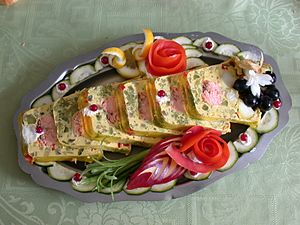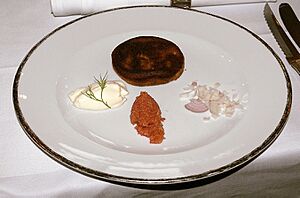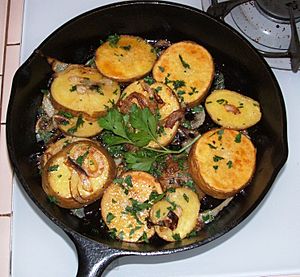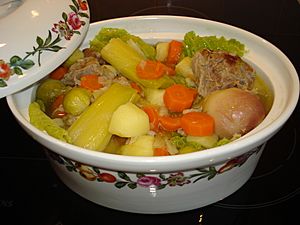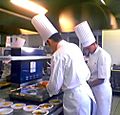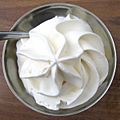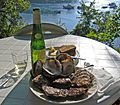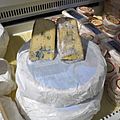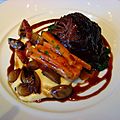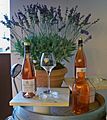French cuisine facts for kids
French cuisine is a famous style of cooking. It has inspired many other types of food across Europe. French chefs are known all over the world.
French cooking became more modern thanks to chefs like La Varenne (1615–1678) and Marie-Antoine Carême (1784–1833). Carême was even the chef for Napoleon. These chefs made food lighter than in the Middle Ages. They used fewer spices and more herbs. They also added creamy ingredients.
They created new cooking ideas. These included roux (a mix of fat and flour for thickening) and fish stock. They also invented ways to marinate food and dishes like ragout (a slow-cooked stew). Carême was also a master pastry-maker. This skill is still a big part of French cooking today. He created important basic sauces, called 'mother sauces'. From these, he could make over a hundred different sauces!
Contents
The Father of Modern French Cooking
Georges Auguste Escoffier (1846–1935) helped make French cooking popular in the 1900s. He was very good at organizing kitchens. He figured out how to run big restaurants in hotels or palaces. He planned how staff should work and how menus were made. Escoffier managed famous restaurants. These included the Savoy Hotel and Carlton Hotel in London. He also worked at the Hôtel Ritz Paris and on large cruise ships.
Escoffier also wrote a book called Le Guide Culinaire in 1903. This book helped spread French cooking ideas everywhere. But Escoffier's book didn't include all the special foods from different regions of France.
Exploring French Regional Dishes
In the 20th century, people started to discover the rich food of the French countryside. This was helped by food tourism and the Guide Michelin. Many dishes that were once only found in one area are now popular across France.
Cheese and wine are very important in French cooking. They are used differently in various regions.
- In the north of France, people often use butter for cooking.
- In the south, they prefer olive oil and garlic.
Each region in France has its own special dish.
- Choucroute is from Alsace.
- Quiche is from Lorraine.
- Cassoulet is from the Languedoc-Roussillon.
- Tapenade is from Provence-Alpes-Côte d'Azur.
In November 2010, UNESCO added French food to its list of 'intangible cultural heritage'. This means French cooking is seen as a special part of the world's culture.
Images for kids
-
A nouvelle cuisine presentation
-
John, Duke of Berry enjoying a grand meal. The Duke is sitting with a cardinal at the high table, under a luxurious baldaquin, in front of the fireplace, tended to by several servants, including a carver. On the table to the left of the Duke is a golden salt cellar, or nef, in the shape of a ship; illustration from Très Riches Heures du Duc de Berry, circa 1410.
-
The Polish wife of Louis XV of France, Queen Marie Leszczyńska, influenced French cuisine.
-
Marie-Antoine Carême was a French chef and an early practitioner and exponent of the elaborate style of cooking known as grande cuisine
-
Georges Auguste Escoffier was a French chef, restaurateur and culinary writer who popularized and updated traditional French cooking methods
-
Grand sechoir, Museum of the Walnut in Vinay, Isère
-
Drome apricots
-
Pot-au-feu is a cuisine classique dish.
-
Steak frites is a simple and popular dish.
-
Typical French pâtisserie
-
Alsatian Flammekueche
-
Escargots, with special tongs and fork
-
Comté cheese and Vin jaune
-
Poulet de Bresse chicken salad
-
Rosette de Lyon charcuterie
-
Noix de Grenoble, unusual trilaterally symmetric walnut
-
Beaufort cheeses ripening in a cellar
-
A terrine of foie gras with a bottle of Sauternes
-
Black Périgord Truffle
-
Roquefort cheese
-
Blé (Wheat)
See also
 In Spanish: Gastronomía de Francia para niños
In Spanish: Gastronomía de Francia para niños


